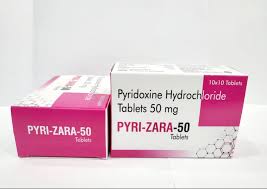Here is the detailed pharmaceutical profile for:
💊 Pyridoxine Tablet 50 mg
(Vitamin B6)
✅ DESCRIPTION
Pyridoxine hydrochloride is the most common form of Vitamin B6, a water-soluble vitamin essential for protein metabolism, neurotransmitter synthesis, immune function, and red blood cell production. The 50 mg dose is typically used in therapeutic supplementation, particularly for deficiency correction or drug-induced B6 depletion.
⚖️ COMPOSITION
- Each tablet contains:
- Pyridoxine Hydrochloride … 50 mg
- Excipients … q.s.
🧪 NATURE
- Solid oral dosage form
- Typically white or light-colored tablets
- May be scored for easy splitting
📌 USES
- Treatment of moderate to severe Vitamin B6 deficiency
- Management of isoniazid- or penicillamine-induced neuropathy
- Used in homocystinuria, xanthurenic aciduria
- Treatment of nausea and vomiting in pregnancy (as part of combination therapy)
- Premenstrual syndrome (PMS)
- Peripheral neuropathy (diabetic, alcoholic, medication-induced)
🌟 ADVANTAGES
- Higher dose provides effective therapeutic correction
- Supports nervous system and liver function
- Improves mood, sleep, and immune balance
- Useful in pregnancy-related nausea when combined
⚠️ PRECAUTIONS
- Prolonged use of >100 mg/day may lead to sensory neuropathy
- Caution in patients with renal or hepatic impairment
- Monitor in cases of long-term high-dose therapy
❌ CONTRAINDICATIONS
- Known hypersensitivity to pyridoxine
- Caution in Parkinson’s disease patients on levodopa monotherapy (pyridoxine can reduce its effect)
💢 SIDE EFFECTS (rare at 50 mg)
- Tingling or numbness (with prolonged use)
- Headache or mild nausea
- Photosensitivity (rare)
💊 DOSAGE & ADMINISTRATION
- Usual therapeutic dose:
- 50 mg once or twice daily, depending on condition
- Should be taken with food or after meals
📦 PACKING
- Blister packs of 10, 15, or 30 tablets
- Labeled with dosage, batch number, and expiry date
🧊 STORAGE
- Store at cool, dry place, below 25°C
- Protect from light and moisture
- Keep away from children

